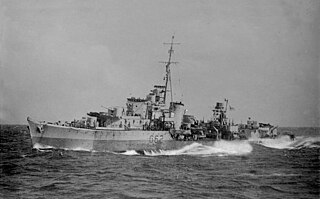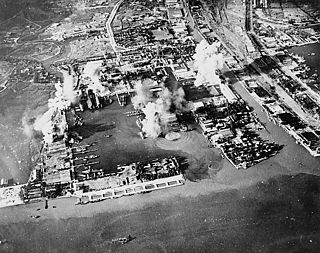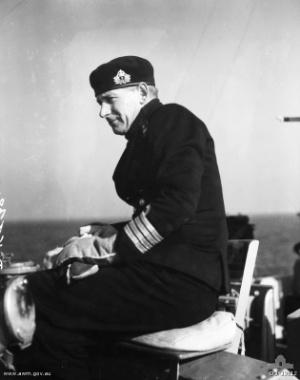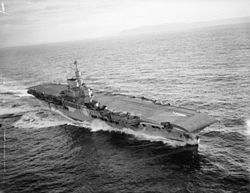
HMS Victorious was the third Illustrious-class aircraft carrier after Illustrious and Formidable. Ordered under the 1936 Naval Programme, she was laid down at the Vickers-Armstrong shipyard at Newcastle upon Tyne in 1937 and launched two years later in 1939. Her commissioning was delayed until 1941 due to the greater need for escort vessels for service in the Battle of the Atlantic.

HMS Illustrious was the lead ship of her class of aircraft carriers built for the Royal Navy before World War II. Her first assignment after completion and working up was with the Mediterranean Fleet, in which her aircraft's most notable achievement was sinking one Italian battleship and badly damaging two others during the Battle of Taranto in late 1940. Two months later the carrier was crippled by German dive bombers and was repaired in the United States. After sustaining damage on the voyage home in late 1941 by a collision with her sister ship Formidable, Illustrious was sent to the Indian Ocean in early 1942 to support the invasion of Vichy French Madagascar. After returning home in early 1943, the ship was given a lengthy refit and briefly assigned to the Home Fleet. She was transferred to Force H for the Battle of Salerno in mid-1943 and then rejoined the Eastern Fleet in the Indian Ocean at the beginning of 1944. Her aircraft attacked several targets in the Japanese-occupied Dutch East Indies over the following year before Illustrious was transferred to the newly formed British Pacific Fleet (BPF). The carrier participated in the early stages of the Battle of Okinawa until mechanical defects arising from accumulated battle damage became so severe she was ordered home early for repairs in May 1945.

HMS Quality (G62/D18) was a Q-class destroyer built for the Royal Navy. Entering service in 1942, the destroyer served in several theatres of World War II. Following the war's conclusion, the ship was transferred to the Royal Australian Navy (RAN), commissioning as HMAS Quality (G62/D262) in late 1945. Unlike her sister ships, which were refitted as anti-submarine frigates, Quality was not modified, decommissioned after only 59 days of service, and was sold for scrap in 1958.

HMS Formidable was an Illustrious-class aircraft carrier ordered for the Royal Navy before the Second World War. After being completed in late 1940, she was briefly assigned to the Home Fleet before being transferred to the Mediterranean Fleet as a replacement for her crippled sister ship Illustrious. Formidable's aircraft played a key role in the Battle of Cape Matapan in early 1941, and they subsequently provided cover for Allied ships and attacked Axis forces until their carrier was badly damaged by German dive bombers in May.

The British Pacific Fleet (BPF) was a Royal Navy formation that saw action against Japan during the Second World War. It was formed from aircraft carriers, other surface warships, submarines and supply vessels of the RN and British Commonwealth navies in November 1944.

The Indian Ocean raid, also known as Operation C or Battle of Ceylon in Japanese, was a naval sortie carried out by the Imperial Japanese Navy (IJN) from 31 March to 10 April 1942. Japanese aircraft carriers under Admiral Chūichi Nagumo struck Allied shipping and naval bases around British Ceylon, but failed to locate and destroy the bulk of the British Eastern Fleet. The Eastern Fleet, commanded by Admiral Sir James Somerville, was forewarned by intelligence and sailed from its bases prior to the raid; its attempt to attack the Japanese was frustrated by poor tactical intelligence.

Operation Cockpit was an Allied attack against the Japanese-held island of Sabang on 19 April 1944. It was conducted by aircraft flying from British and American aircraft carriers and targeted Japanese shipping and airfields. A small number of Japanese ships and aircraft were destroyed, and one American aircraft was lost. While the attack was successful tactically, it failed to divert Japanese forces from other areas as had been hoped.

Operation Inmate was an attack by the British Pacific Fleet against Japanese positions on Truk Atoll in the central Pacific Ocean during the Second World War. The attacks against the isolated islands on 14 and 15 June 1945 were conducted to provide combat experience for the aircraft carrier HMS Implacable and several of the fleet's cruisers and destroyers ahead of their involvement in more demanding operations off the Japanese home islands.

Operation Transom was an attack by Allied forces against the Japanese-occupied city of Surabaya on the Indonesian island of Java during World War II. Conducted by the British-led Eastern Fleet, the operation took place on 17 May 1944 and involved American and British carrier-based aircraft bombing the city's docks and an oil refinery. An American torpedo bomber was shot down, and two British torpedo bombers were lost in accidents.

HMS Roebuck was an R-class destroyer of the British Royal Navy that saw service during World War II. She was the fifteenth ship to carry this traditional ship name, after a small deer native to the British Isles, which was used as far back as the reign of Queen Elizabeth I.

Rear Admiral Otto Humphrey Becher, & Bar was a senior officer in the Royal Australian Navy (RAN). Born in Harvey, Western Australia, Becher entered the Royal Australian Naval College in 1922. After graduating in 1926, he was posted to a series of staff and training positions prior to specialising in gunnery.

Ronald Cuthbert Hay, was a British naval aviator and the only Royal Marine fighter ace. He joined the Royal Marines in 1935 and then served as an aviator with the Fleet Air Arm. In 1940 he joined 801 Naval Air Squadron flying the two seater Blackburn Skua on HMS Ark Royal for the Norwegian campaign, claiming his first victory on his first operational flight. He took part in operations covering the evacuation of the British Expeditionary Force from the Dunkirk beaches. Flying the Fairey Fulmar, he joined 808 Naval Air Squadron during the Battle of Britain.

The Eastern Fleet, later called the East Indies Fleet, was a fleet of the Royal Navy which existed between 1941 and 1952.

Operation Banquet was a British naval operation in the Second World War, commanded by Rear Admiral Clement Moody. The objective was to bomb Japanese positions in and around Padang, on the south-western coast of Sumatra, in Indonesia, on 24 August 1944. The primary targets of the attack, Padang airfield, the Indaroeng cement works, and the harbor facilities and shipping at Emmahaven were hit.

Operation Goodwood was a series of British carrier air raids conducted against the German battleship Tirpitz at her anchorage in Kaafjord in occupied Norway during late August 1944. It was the last of several attacks made by the Home Fleet during 1944 which sought to damage or sink Tirpitz and thereby eliminate the threat it posed to Allied shipping. Previous raids on Kaafjord conducted by Fleet Air Arm aircraft had involved only one air attack; in Operation Goodwood several attacks were made in a single week. The Royal Navy hoped that these raids would wear down the formidable German defences.
Operation Robson was the first of a series of aerial operations, Operation Outflank, undertaken by the British Pacific Fleet (BPF) against the oil refineries of Japanese-occupied Sumatra during World War II. Admiral Chester Nimitz, Commander in Chief, Pacific Ocean Areas, proposed a strike on the refineries to Admiral Bruce Fraser, commander of the BPF, during a meeting in early December.

885 Naval Air Squadron was a Naval Air Squadron of the Royal Navy's Fleet Air Arm. First formed on 1 March 1941, the squadron served as a fighter squadron during the Second World War. It operated in the Mediterranean in 1942–43, where it took part in Operation Torch, the Anglo-American invasion of French North Africa, the Allied invasion of Sicily and the Allied invasion of Italy. In 1944 it took part in the Allied invasion of Normandy, spotting for Allied artillery bombardments and in 1945, was deployed as part of the British Pacific Fleet. It was abolished for the last time on 27 September 1945.

715 Naval Air Squadron was a Fleet Air Arm (FAA) naval air squadron of the United Kingdom’s Royal Navy (RN) created in July 1936 to serve as a catapult flight of the Fleet Air Arm of the Royal Air Force. It was elevated to squadron status at the end of 1937, before being disbanded in January 1940. It was re-formed in August 1944 to operate as the Fighter Wing of the School of Air Combat, before being disbanded in March 1946, and absorbed into 736 Naval Air Squadron.

772 Naval Air Squadron was a Fleet Air Arm (FAA) naval air squadron of the United Kingdom’s Royal Navy (RN) which last disbanded during September 1995. 772 Naval Air Squadron formed as a Fleet Requirements Unit out of 'Y' Flight from 771 Naval Air Squadron at RNAS Lee-on-Solent in September 1939. While the headquarters remained there, floatplanes were operated out of RNAS Portland, however, mid 1940 saw the whole squadron move north to RNAS Campbeltown and roughly twelve months afterwards the short distance to RNAS Machrihanish. The unit moved to RNAS Ayr in July 1944 and became the Fleet Requirements Unit School. In January 1946 the squadron moved to RNAS Burscough in Lancashire, before moving to RNAS Anthorn in Cumberland, in May. It became the Northern Fleet Requirements Unit upon moving to RNAS Arbroath, in June 1947, but disbanded into 771 Naval Air Squadron in October. 772 Naval Air Squadron reformed as a Helicopter Support Squadron at RNAS Portland in September 1974. In September 1977 the squadron took over responsibility for a number of Ships' Flights of Royal Fleet Auxiliary ships. The squadron was used to reform 848 Naval Air Squadron for the Falklands Task Force in 1982, with the Ships' Flights absorbed into 847 Naval Air Squadron. In August 1982 it took on the Anti-Submarine Warfare Flight from 737 Naval Air Squadron and between 1983 - 1985 a Search and Rescue Flight operated out of RNAS Lee-on-Solent.

Operation Stab was a British naval deception during the Second World War to distract Japanese units for the forthcoming Guadalcanal campaign by the US armed forces.




















